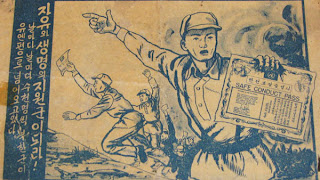According to historians, 2.5 billion propaganda leaflets were dropped by American aircraft in the Korean peninsula during the Cold War. A new South Korean museum called "Memories of Propaganda" opened in April and includes 700 of these so-called "paper bombs" North & South Korea and the United States. Since collecting the leaflets during the Cold War was considered illegal in both states, some of the older leaflets dating back to the 50s are very rare. The debris from the Cold War are collector's items - the owner, Jin Yong-seon, recalls in a NYTimes article - like what chips from the Berlin Wall are to Germans. In this North Korean leaflet pictured left, for example, Roh Tae Woo, one of South Korea's former presidents during the 90s, kneels before James Lilley (the American Ambassador in Seoul) to take his orders.
A new South Korean museum called "Memories of Propaganda" opened in April and includes 700 of these so-called "paper bombs" North & South Korea and the United States. Since collecting the leaflets during the Cold War was considered illegal in both states, some of the older leaflets dating back to the 50s are very rare. The debris from the Cold War are collector's items - the owner, Jin Yong-seon, recalls in a NYTimes article - like what chips from the Berlin Wall are to Germans. In this North Korean leaflet pictured left, for example, Roh Tae Woo, one of South Korea's former presidents during the 90s, kneels before James Lilley (the American Ambassador in Seoul) to take his orders.
When Jin was younger, he found these leaflets scattered all over the hills where he grew up. "If we found them, we were supposed to report them to the police station. We got comic books, pencils or sweets as a reward." As he collected them over the years, the museum began to develop. Much of the propaganda is easy to understand pictorially, but many of it relies on culturally-specific understandings. Much of the North Korean propaganda relies on the power of proverbs, sayings, and folklore characters to dismiss South Korean and American propaganda. For example, North Korean propagandists dismiss Washington's charges against its nuclear weapons program with the saying: "The dog barks, but the caravan continues." (Why stop the revolution for that silly dog who barks at everything?)
Much of the propaganda is easy to understand pictorially, but many of it relies on culturally-specific understandings. Much of the North Korean propaganda relies on the power of proverbs, sayings, and folklore characters to dismiss South Korean and American propaganda. For example, North Korean propagandists dismiss Washington's charges against its nuclear weapons program with the saying: "The dog barks, but the caravan continues." (Why stop the revolution for that silly dog who barks at everything?) Both sides, however, use propaganda that promises defectors "cash, houses, medals and women," the NYTimes reports. One North Korean defector said when he saw a naked woman on a South Korean leaflet that he "would never see such a thing in North Korea. But it also reinforced our indoctrination that South Koreans were depraved capitalists."
Both sides, however, use propaganda that promises defectors "cash, houses, medals and women," the NYTimes reports. One North Korean defector said when he saw a naked woman on a South Korean leaflet that he "would never see such a thing in North Korea. But it also reinforced our indoctrination that South Koreans were depraved capitalists."
One leaflet (shown above) depicts Communist soldiers being shot as they try to invade the South. The leaflet below it boasts of the miracles of capitalism, showing South Koreans vacationing on beaches and trumpeting the number of cars produced in the South. It seems neither side saw their own propaganda as much as they saw the enemy's, perhaps they did not see it at all. There is hardly any way to compare the accuracy of the enemy's boastful propaganda, inasmuch as you would need to defect in order to verify it. The South Korean propaganda, however, seems more effective in that it critiqued the North Korean economic system, sent American dollars in the leaflets, and enticed men with provocative images.
Perhaps that merely reflects on the effectiveness of state communist propaganda in general - it's never very effective. The old Soviet films, the posters, the contrived parades and silly reenactments of revolutionary history: none of it is really as effective as the self-sustaining spectacle in capitalist societies. Christian missionaries, corporate advertising, the constant development and performance of the spectacle in all its manifestations: news, images, culture, music, lifestyle, art, sex, etc. have done more to spread the message of capitalism than the capitalist governments have, and this works to its advantage. Poor communists and peasant societies can hardly resist.
View ten slides from the archive here.
.png)



2 comments:
Fascinating post. I wonder if any scholars have written histories of war-leaflets. I haven't seen examples of the ones we dropped on Iraq.
Great post. I case you didn't know, I think your blog is "excellent."
Post a Comment